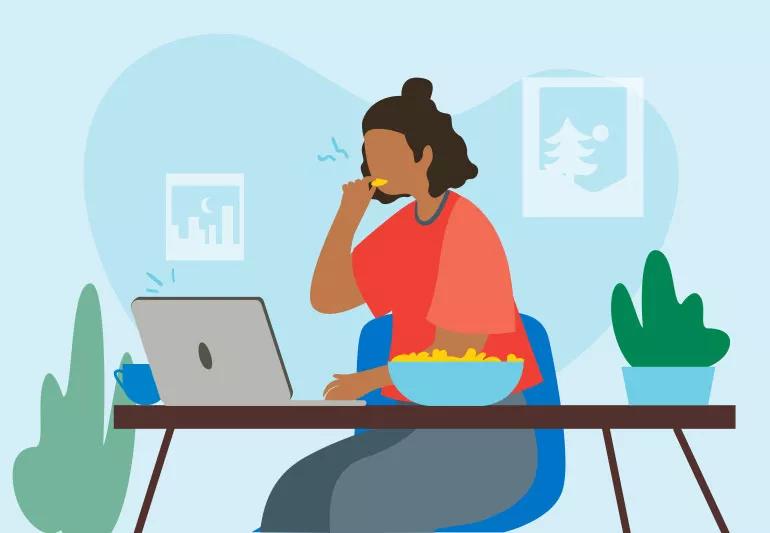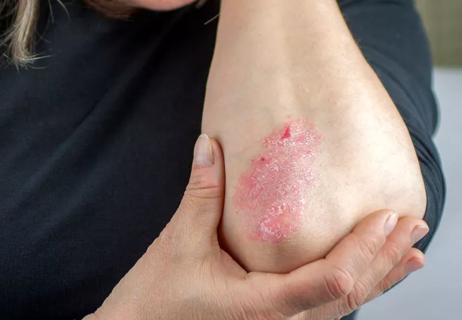You can learn other ways to soothe yourself, including distraction and mindfulness

After an argument with your family, you’re now stuffing leftover pasta into your mouth like a zombie. You had a tough day at work, and now you feel like you could eat an entire pizza. Or maybe you don’t even realize how stressed out you are, but you know that you feel compelled to eat everything in sight.
Advertisement
Cleveland Clinic is a non-profit academic medical center. Advertising on our site helps support our mission. We do not endorse non-Cleveland Clinic products or services. Policy
“Food is available 24/7. It’s legal, it’s easy to obtain and it feels good,” says psychologist Susan Albers, PsyD. “It’s no surprise that we make a beeline for food whenever we feel stressed.”
She explains why stress eating happens and how you can put a stop to it.
When you’re feeling stressed or overwhelmed, your body pumps out cortisol, the hormone that kicks off your fight-or-flight instincts. This bodily response goes back to caveman times, when our Paleolithic ancestors needed energy to, say, fight off saber-toothed tigers. Cortisol increased their appetites, and those extra calories gave them the fuel they needed to literally stay alive and fight.
But these days, the stressors that can set off our cortisol production are much less immediately threatening than the wild animals of old. But they still trigger the same fight-or-flight instincts and the same desire to turn to food.
“Today, many things can, unfortunately, kick off that stress response, from your phone ringing to a busy pick-up line at your child’s school,” Dr. Albers says. Of course, you don’t need extra calories to fight off a phone call — but try telling that to your brain!
Food triggers not only a chemical reaction, but an emotional response, too, all to try to help you feel better and take away your stress.
Advertisement
“You might notice that you’re attracted to a certain type of food when you’re stressed, like chocolate or salt,” Dr. Albers notes, “and certain foods are linked with the feelings of childhood.” If you grew up feeling comforted by your grandma’s soup or your dad’s cookies, you may crave those foods in stressful times.
But there’s one major catch: It doesn’t really work. Research shows that stress eating only makes us feel better for about three minutes. “That’s not very long or worth the aftermath,” Dr. Albers says.
If stress eating doesn’t actually improve your stress levels, what does? It goes back to the stress itself.
“Stress eating is about escaping your feelings, pushing them away,” Dr. Albers explains, “so the key to getting a handle on it is understanding your stress better.”
But with intentionality and effort, you can break the habit and form new ones in its place. “Forming new habits in response to stress takes time, but it is possible,” she adds.
Dr. Albers shares recommendations for reining in your stress eating once and for all.
Stress eating is often an automatic, knee-jerk reaction that you may not even recognize in the moment. It’s both a habit and a learned response.
“Mindfulness is an antidote to stress eating,” Dr. Albers says. “It helps to put a conscious moment of pause in between.” When you’re about to start snacking, try the S.T.O.P. technique:
“One of the reasons eating doesn’t remove stress for very long is because eating is about pleasure,” Dr. Albers explains. “When you’re stressed, you need soothing not pleasure. They’re different.”
So, how can you figure out what soothes you? Get out a piece of paper and do the 5-5-5-5-5 exercise. Write down:
“Hang this list in an easy-to-see location, like on your refrigerator or cupboard, and look at it when you need a reminder to create a diversion,” Dr. Albers says. “Then, do that diversion for at least five minutes.”
Have you ever used a squeegee on a window or maybe on a dirty car windshield? With one simple, sweeping motion, you can wipe it clean, leaving a shiny, clear pane of glass in its place.
Advertisement
Dr. Albers suggests a technique called “squeegee breath,” designed to wipe away your stress — and with it, your desire to stress eat:
“Use this imagery when you need to let go of stress, worry or irritation,” Dr. Albers advises.
Nothing says comfy and cozy like a warm mug of tea. And it’s actually been shown to reduce cortisol levels. One study showed that six weeks of tea drinking lowered cortisol levels and promoted relaxation. There are other benefits to drinking tea, too, making it a great choice for multiple reasons.
Who doesn’t love a relaxing massage? Multiple studies show that foot massage and reflexology can help reduce anxiety and depression. “When you experience the urge to stress eat, try self-massage for a less expensive, on-demand version of a spa appointment,” Dr. Albers suggests.
A foot roller or massager will do the trick, but you can also use props you already own. Sitting upright in a chair, spend five minutes rolling your foot over a tennis ball, a broom handle or a frozen water bottle.
Advertisement
This popular pantry staple has been shown to help regulate blood sugar in people who have diabetes, making it a helpful tool for curbing emotional eating. It’s also a warming agent that can help relax and soothe your muscles.
Here’s how Dr. Albers suggests tapping into the benefits of cinnamon:
Golfer Tim Kite once said, “You can always find a distraction if you’re looking for one.” And while distraction can sometimes be a bad thing (hello, term paper due tomorrow morning!), it’s a good way to divert yourself from stress eating.
“Distraction can go a long way in breaking you free from stress and emotional eating,” Dr. Albers notes. “When you feel overwhelmed or are ruminating about a problem, it’s important to move and act in a new way and to have a very specific plan in place.”
She suggests picking up a new hobby: origami! Research shows that this particular activity stimulates the frontal cortex, the part of your brain responsible for making decisions — including decisions about food.
Advertisement
“Take a dollar from your wallet and just begin to fold, or seek out ‘dollar origami’ designs that will keep your brain entertained and challenged to the point that you won’t be thinking about food,” Dr. Albers says.
This relaxing trend, which is big in Japan and other parts of Asia, doesn’t involve taking an actual bath in the woods. Forest therapy is more like a bath for your mind. In a 2014 study, some participants sat in an urban environment for 15 minutes, while others sat in a forest for the same amount of time.
“It found that people who sat in the forest experienced less anxiety and tension and reported feeling calmer, more relaxed and rejuvenated than those sitting outside in an urban environment,” Dr. Albers says.
“Shame and guilt aren’t helpful or necessary,” Dr. Albers states. “If you ask yourself where the guilt is coming from, you may find that it’s from often self-judgement or the internalized voice of someone else, like a parent, who has made you feel bad about your eating in the past.”
Instead of being critical of your stress eating, try to be curious about it. Ask yourself questions like:
Dr. Albers also emphasizes that a little bit of stress eating isn’t a big deal. “Diet culture wants to make you believe that we are ‘bad’ for doing a little stress eating,” she says, “but if it sometimes makes you feel good in times of stress, that’s OK.”
Stress eating is a normal behavior, but it can also be an aspect of disordered eating. “We all do it, to some extent, even healthy eaters,” Dr. Albers says, “but stress eating evolves into disordered eating when it becomes the problem instead of the solution to how you feel.”
Your stress eating may be a problem if it:
Practices like mindfulness, mindful eating and intuitive eating can all help you start to better understand what you’re feeling and how to respond.
But if you’re struggling with frequent, out-of-control or problematic stress eating and can’t seem to stop, it may be time to bring in an expert.
“Stress management is a great first step,” Dr. Albers encourages. “Therapists can be helpful in understanding your triggers and stepping up new behavioral routines to respond to stress.”
Learn more about our editorial process.
Advertisement

Fill your coping toolbelt with healthy skills like getting outside, writing in a journal, volunteering, laughing or talking with a friend

We all experience some stress from time to time, but chronic stress can contribute to health issues like diabetes and cardiovascular disease

Getting outside, eating a healthy diet, taking up journaling, listening to music — even cuddling a pet — can provide stress relief

Give these 30+ grocery items a try to help find relief

In response to stress or danger, your brain responds by either defending itself, running away, stopping or reconciling

From nausea, weight gain and eczema, stress can affect your immune system in many ways

Stress hormones trigger cravings in an attempt to keep us safe from danger

From stomachaches and hives to sleepless nights and missed periods, stress can make an impact

The best parenting style balances enforcing rules and showing plenty of love

Tips include cutting back on sugar, focusing on exercise and managing stress

It can be harder to let go when you’ve invested time, energy and emotions — but it might be the healthier choice long term